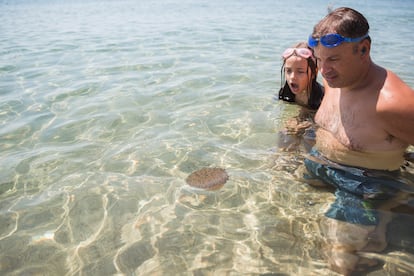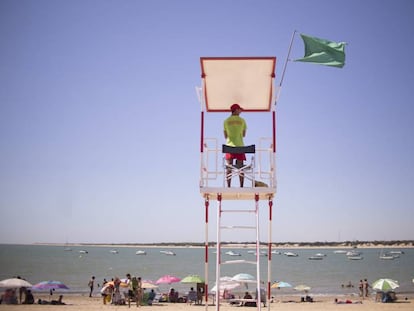Basic first aid guide for sunburn, insect bites and other incidents children may face in summer
While on vacation, your kids can be exposed to jellyfish stings, cold shock response and many kinds of injuries. Here’s how you can deal with them

Swimming pools, beaches, games in the park, water balloon fights, spending a few days with the grandparents, summer camps... the summer break is a great moment of leisure for children, and it is important that they are prepared to enjoy it to the fullest. Keeping hydrated and avoiding prolonged overexposure to the sun and during the central hours of the day, for instance, are some of the tips shared by Manuel Viso, a specialist in hematology and head of the Emergency Department at the San Rafael Hospital in A Coruña, Spain, and Lucía Camba, an early childhood educator specializing in child nutrition and active pedagogies. Both are the creators of the Malumecuida education and health community for families and education and health professionals.
The endless activities that take place during the summer can also lead to many unforeseen incidents. For this reason, Viso shares his advice to deal with some of the things that can occur during the summer season, such as heatstroke. When this happens, Viso emphasizes that it is necessary to “take the child to a cool and ventilated place and, if they don’t feel dizzy, place them in a semi-sitting position, with their head raised.” If they are conscious, he also recommends giving them small sips of water “and calling 911 if the situation gets complicated.”
Of course, this is not the only problem that can arise during vacations with children. Here, the doctor offers some more guidelines that can help you to be prepared for the different situations you can face:
1. Cold shock response (hydrocution). It happens when there is a sudden change in temperature, from hot to cold, of more than five degrees Celsius (41 Fahrenheit). For instance, when jumping into the water. In these cases, the child begins to turn pale and experiences chills, dizziness, blurred vision, stomach pain, ringing in the ears and could even faint. In the worst-case scenario, there could be a cardiorespiratory arrest. The first thing to do is take the child out of the water, place them on the ground with their legs straight and raised, and cover them if they have chills. Their head is then turned to the side, in case they vomit, and the ribcage is checked for pulse and movement to see if they are in cardiorespiratory arrest. If that is the case, cardiopulmonary resuscitation must be performed. If the child ate before entering the cold water, the clinical picture worsens due to the sequestration of blood in the digestive system, as there is less blood in the brain. The best thing to do is to enter the water gradually; if they have just eaten, they should wait for one to two hours.
2. Sunburns. They can be first-degree (erythema) or second degree, with blisters. It is important to apply soothing creams, available in drugstores. In addition, the child must drink plenty of water and take cool showers or baths (avoiding pressurized water) or apply ice to the area. Acetaminophen or ibuprofen can be taken for the pain. In these situations, comfortable and loose clothing should be worn and care should be taken to ensure that there is no inflammation and traces of suppuration in the burns.
3. Drowning. This is one of the main causes of accidental death in children, and a high percentage takes place in private pools. When removing the child from the water, it is necessary to check their vital parameters, such as consciousness, breathing and pulse. If they do not breathe or have a pulse, perform cardiopulmonary resuscitation. Next, the child’s clothes should be removed, especially if the water is cold, and they should be wrapped in dry clothes. If they are just dizzy, they should be placed in the lateral safety position (one arm and one leg flexed). If they are unconscious you have to call 911, always keeping an eye on them. “To minimize the risks of swimming pool accidents, it is convenient that they are fenced, so that they cannot be accessed when the lifeguard is not present,” warns Manuel Viso. In addition, “the depth of the pool must be clearly marked, diving must be prohibited and there must be flotation devices on hand to serve as lifesaving devices,” as Roberto Barcala, professor of lifeguarding at the faculty of education and sports sciences of the University of Vigo (Spain), explained to EL PAÍS in 2022.
4. Nosebleeds. The nose has a large number of blood vessels that can break due to irritative processes or with certain colds. It also moves air, and the membranes lining the inside of the nostrils can become irritated. With this type of hemorrhage, the child’s head must be tilted slightly forward and the bleeding nostril must be pressed. If it does not stop, a folded gauze pad is inserted and pressed. If that is still not enough, you can use another one. If the situation continues, the minor must be taken to the hospital.
5. Insect bites (mosquitoes, wasps, spiders). In case of a wasp sting, the main thing is to try to remove the stinger. It should not be removed with tweezers, but rather with a credit card or something of the kind (an ID card or a piece of hard cardboard), dragging it diagonally over the skin until it reaches the stinger. If the bite it is on arms or legs, it is necessary to remove rings or bracelets and apply cold compresses, but not ice. It is also convenient to clean the area with soap and water or with saline or antiseptic solutions. The area should not be scratched, because the liquid-poison can penetrate further. For pain, analgesics and antihistamines can be taken, topically or orally, if there is redness or itching, always with a prescription.
6. Jellyfish stings. Wash the area with seawater (never fresh water) and apply cold compresses. If there is no improvement, the child should be transferred to the hospital. Dead jellyfish and the remains of tentacles can also sting and inject the stinging fluid.
7. Wounds. First of all, clean them (with clean hands). If blood has been drawn, the area must be pressed with gauze and compressed with your hand. If it is a leg or an arm and the bleeding does not stop, raise the limb. In wounds where something is stuck, never remove it or apply a tourniquet unless there is a risk of hypovolemia (massive blood loss where a hypovolemic shock with the possibility of death occurs). A tourniquet is not recommended in other circumstances because it causes an obstruction of blood circulation. Once the bleeding is controlled, an antiseptic treatment is performed and the wound is covered. If during the following hours it looks reddened, it is advisable to go to the hospital.
Sign up for our weekly newsletter to get more English-language news coverage from EL PAÍS USA Edition
Tu suscripción se está usando en otro dispositivo
¿Quieres añadir otro usuario a tu suscripción?
Si continúas leyendo en este dispositivo, no se podrá leer en el otro.
FlechaTu suscripción se está usando en otro dispositivo y solo puedes acceder a EL PAÍS desde un dispositivo a la vez.
Si quieres compartir tu cuenta, cambia tu suscripción a la modalidad Premium, así podrás añadir otro usuario. Cada uno accederá con su propia cuenta de email, lo que os permitirá personalizar vuestra experiencia en EL PAÍS.
¿Tienes una suscripción de empresa? Accede aquí para contratar más cuentas.
En el caso de no saber quién está usando tu cuenta, te recomendamos cambiar tu contraseña aquí.
Si decides continuar compartiendo tu cuenta, este mensaje se mostrará en tu dispositivo y en el de la otra persona que está usando tu cuenta de forma indefinida, afectando a tu experiencia de lectura. Puedes consultar aquí los términos y condiciones de la suscripción digital.
More information
Últimas noticias
Most viewed
- Reinhard Genzel, Nobel laureate in physics: ‘One-minute videos will never give you the truth’
- Pablo Escobar’s hippos: A serious environmental problem, 40 years on
- Charles Dubouloz, mountaineering star, retires at 36 with a farewell tour inspired by Walter Bonatti
- Why we lost the habit of sleeping in two segments and how that changed our sense of time
- The fall of a prolific science journal exposes the billion-dollar profits of scientific publishing











































